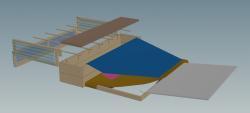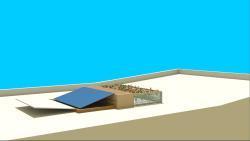Hello,
I'm a novice gardener making my first attempt at growing tomatoes in my condo. I live in Montreal, Canada, where the growing season is approximately April to October. I've already begun growing tomatoes on my balcony, but the space is limited so I want to migrate some of them to my rootop.
My roof has pros and cons as a gardening site:
pro:
lots of sunlight (around 9 hrs)
lots of space
con:
very windy
awkward to access (ladder through trapdoor), esp when transporting materials, including water
I work in computer animation and have used 3d software to design a planter setup that is intended to do the following things:
PROTECT THE PLANTS FROM WIND
The tomatoes are grown horizontally along stakes elevated 1' from the ground and surrounded by panels made of corrugated transparent plastic mounted on wooden frames. These panels block the wind but let the sun in.
COLLECT RAINWATER
Next to the box that contains the soil, rainwater is collected in a tray made of a wooden frame covered by a tarp (brown). This is in turn covered by another tarp (blue) that is suspended over the collection tray to prevent evaporation, and slanted to prevent water buildup. NOT SHOWN (because it's difficult to model): the blue tarp comes down on the sides and tucks into the tray, so there is no opening for the water to evaporate. Water runs off the blue tarp and collects in the tray. Note that there is also a ramp (support for ramp not shown) that drains into the tray, but I'm not sure if I'll use that in the end because it might be difficult to pin it down and prevent it from being blown away.
"SELF-WATER" THE PLANTS, IE. WICK THE COLLECTED RAIN INTO THE SOIL
An absorbant fabric (pink) - perhaps a towel - wicks water from the collection tray to the soil box, ensuring that the soil is always moist.
This design is not intended to be 100% self-sustaining; I will have to prune suckers + monitor the plants, and I will likely need to manually top up the rain in the tray if it doesn't rain for a long time, but the idea is to have it as low-mainenance as possible.
Here are my questions:
Does this general design seem viable?
Currently the six plants are spaced 16" apart. Is that a good distance?
Currently the box containing the soil is 8' long x 1.45' tall x 2' wide, = 23.2 cubic feet, which is 3.87 cubic feet per plant. Is that sufficient soil in the container?
Currently the stakes are elevated about 1' above the ground. Is that a good amount of space to prevent them laying on the roof surface? Or can I just forgo the stakes and have the plants spill across the roof within the wind-protected area?
Please feel free to let me know any other concerns or improvements I could make.
Thanks very much!
Jeremy.





